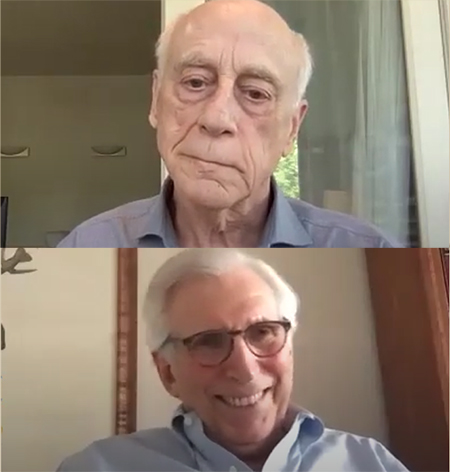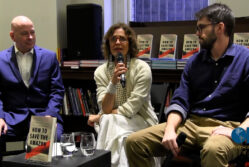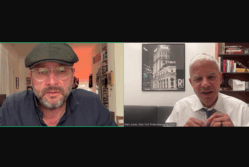Archive Event Highlight

Peter Osnos Recounts Investigating His Own Life for His New Memoir
by Chad Bouchard
During an OPC book night on June 6 with veteran journalist, editor and publisher Peter L. W. Osnos, he called his new book, An Especially Good View: Watching History Happen, a “reported memoir,” because he approached the project as an investigator uncovering the facts of his own life.
“It very much took the time and energy and skills that I developed in decades and decades as a reporter,” he said.
Osnos was born in India in 1943 while his Polish Jewish parents, Józef and Marta, were fleeing the Holocaust. They landed in New York and ultimately settled in Manhattan. In retracing his life, he researched events, fact checked his memories and traveled to Poland, India and Cambodia to get details right.
Osnos cut his teeth as a journalist working for I.F. Stone, and later became a correspondent for The Washington Post, covering the war in Vietnam and the Soviet Union in the Cold War era. He was also the Post’s foreign and national editor.
John Darnton, a Pulitzer-prize winning journalist and novelist who worked over 40 years for The New York Times, lead the discussion.
He asked Osnos about working as assistant for the renowned newsletter I.F. Stone’s Weekly. Stone was an investigative journalist and outspoken supporter of the antiwar and civil rights movements. An OPC Foundation scholarship sponsored by Harper’s Magazine bears his name.
“What he taught me was to believe in what you’re doing, and don’t do it just for the money, because that’s not the answer, and to do it with a voice.”
Osnos talked about another mentor, Benjamin Bradlee, executive editor at The Washington Post from 1965 to 1991, who assigned Osnos to cover the Vietnam War.
In the book, he credits Bradlee with accidentally saving his life. Bradlee was scheduled to visit Vietnam. Osnos had planned to fly to the Cambodian border with a Vietnamese general the day before his arrival. Bradlee changed his plans to arrive a day early, so Osnos cancelled that trip. The helicopter Osnos was scheduled to be on exploded during takeoff, killing everyone on board. He said he was surprised to remember that despite the accident, they all went to lunch and proceeded with their meeting.
“Under normal circumstances, I should have been scared, concerned, flustered, I should have been something. But because I had the reporter’s instinct, which I think most of us who were reporters who grew up in this generation have, I deflected.”
Osnos was also correspondent in Moscow for three years, during which the KGB accused him of being a spy and harassed him. He said he stopped driving for fear that the KGB might stage a car accident, and he kept his hands in his pockets to prevent anyone planting something on him, as in the case of Robert C. Toth of the Los Angeles Times, who was arrested in June 1977 after a scientist handed him a manuscript about parapsychology.
Osnos said he later confirmed he had been a political target after the fall of the Soviet Union, when he read a top-secret file that was unsealed, indicating the Politburo held a meeting to determine what to do about him and dissident Natan Sharansky, who was imprisoned for nine years. A copy of the document, signed by then-KGB head Yuri Andropov, is framed on Osnos’ wall.
In the mid-1980s, Osnos changed careers from journalism to publishing, first at Random House and then at the company he founded, PublicAffairs.
At Random House, he worked with Robert McNamara as editor of his book, In Retrospect: The Tragedy and Lessons of Vietnam. He recalled going over a chapter about the Vietnam War Memorial on the National Mall, when McNamara “blurted out: ‘Look, the war was wrong. Terribly wrong. We owe it to future generations to explain why.’ And I said ‘that’s the book.’ And it was, in essence.”
Osnos was also responsible for books by four presidents, including several books by Jimmy Carter, Between Hope and History by Bill Clinton, Dreams from My Father by Barack Obama, and Donald Trump’s book The Art of the Deal, which was written by journalist Tony Schwartz in 1987. He said he had long seen signs of Trump’s ability to rally supporters, recalling how he’d watched Trump appear in the late 80s at a professional wrestling match in Atlantic City before cheering crowd, which made him feel “uneasy.”
“I think the biggest political mistake of modern American history was underestimating Trump when he ran for president,” he said, adding that the personality Trump projects is not manufactured or fake, but a reflection of his real self. “Trump thrived on a kind of sinister instinct. It is not wrong to compare him to people of the past who had that capacity to connect in a way that’s ultimately sinister.”
During the Q&A, an attendee asked Osnos about the state of press freedom around the world, with many examples of growing authoritarianism and crackdowns, and whether “the bad guys are winning.”
“It will always be a struggle, and it’s one of the reasons why I think journalism is so important,” he said. “There are places and people who need to speak up and speak out. And if you do it, and believe in it, it’s a never-ending battle, but it won’t necessarily be lost.”
Click the window below to watch a playlist of video clips from the program.




